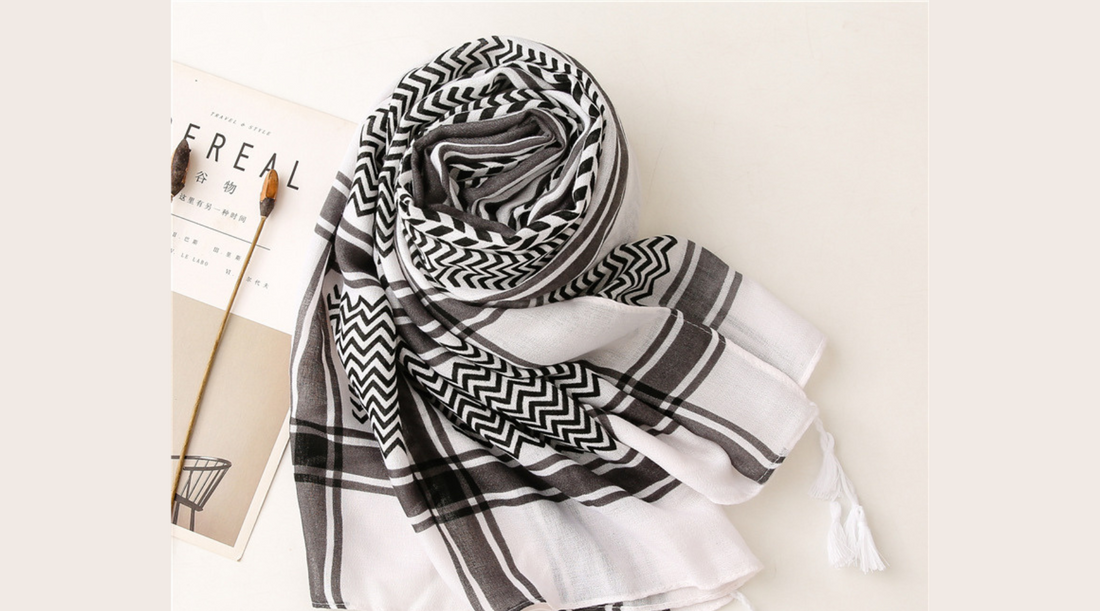Understanding The Keffiyeh, The Shemagh, And The Ghutra
The traditional headwear of the Middle East holds deep cultural significance, with variations such as the Keffiyeh, Shemagh, and Ghutra playing key roles. In this comprehensive guide, we will delve into the distinctions between these headpieces, their cultural implications, and the diverse ways they are worn.
Is Ghutra and Keffiyeh the Same?
The terms Ghutra and Keffiyeh are often used interchangeably, but there are nuanced differences. The Ghutra, primarily worn in the Gulf region, is typically a square piece of cotton or cotton-blend fabric. On the other hand, the Keffiyeh, commonly worn in Palestine, Jordan, and Iraq, can be square or rectangular, and it features a distinctive checkered pattern.
What Is the Difference Between a Keffiyeh and Shemagh?
While both the Keffiyeh and Shemagh share similarities, the key difference lies in their patterns. The Keffiyeh typically showcases a checkered pattern, while the Shemagh often features a larger, more intricate design. Geographical variations also influence the patterns, with the Keffiyeh being more prevalent in the Levant region.
What Is the Difference Between Ghutra and Kufiya?
The terms Ghutra and Kufiya are often used interchangeably, both referring to traditional headwear. However, the Ghutra is commonly associated with the Gulf countries, while the Kufiya is linked to the Levant region, representing a unique cultural identity in each area.
What Do the Colors of Ghutra Mean?
The colors of the Ghutra hold cultural significance. White Ghutras are often worn on formal occasions and symbolize purity and elegance. Red and white checkered Ghutras are more casual and represent a blend of tradition and modernity.
Is It OK to Wear a Ghutra? Can Foreigners Wear a Ghutra?
Wearing a Ghutra is not limited to locals; it is often appreciated when foreigners embrace local customs. However, wearing it correctly and respectfully is crucial. It is a symbol of cultural pride, and donning it appropriately is a sign of cultural awareness and respect.
What Is the Difference Between a Shemagh and a Ghutra? Is It OK to Wear a Shemagh?
The Shemagh and Ghutra are distinct headpieces, with the former featuring larger and more intricate patterns. Both are acceptable to wear, and the choice often depends on cultural preferences. Wearing a Shemagh, especially in regions like North Africa and the Arabian Peninsula, is widely accepted and appreciated.
How Do You Wear a Ghutra?
Wearing a Ghutra involves neatly folding it into a square shape and securing it on the head with an agal (a traditional cord). The agal adds a touch of elegance and helps keep the Ghutra in place.
Why Do Saudis Wear Ghutra? Why Do Qataris Wear a Ghutra?
Wearing the Ghutra in Saudi Arabia and Qatar is a cultural practice that signifies both tradition and practicality. It provides protection from the sun and represents a connection to the rich heritage of the region.
Do Muslims Wear Ghutra?
While not exclusive to Muslims, the Ghutra is commonly worn in Muslim-majority regions as part of traditional attire. It is a cultural symbol more than a religious requirement.
Can I Wear My Keffiyeh at Work?
Wearing a Keffiyeh at work depends on the dress code and cultural norms of the workplace. In regions where it is part of traditional attire, it may be acceptable, but it's essential to be mindful of appropriateness.
What Do Saudis Wear Under Their Robes?
Under their traditional robes (thobes), Saudis typically wear a white undershirt and loose-fitting trousers. The traditional attire is designed to provide comfort in the desert climate.
Why Do Saudis Wear Red and White?
The choice of red and white in Saudi attire, including the Ghutra, is a nod to the national colors. It symbolizes national pride and unity.
What Are the Colors of the Shemagh?
Shemaghs come in various colors, each with its own symbolism. White represents purity, red signifies bravery, and black is associated with resilience. The specific meanings can vary among different communities.
What Does a White Headscarf Mean?
A white headscarf, such as the Keffiyeh or Ghutra, often symbolizes purity, simplicity, and elegance. It is a common choice for formal occasions.
Can a Woman Wear a Keffiyeh?
Absolutely. Women can wear the Keffiyeh as a fashion statement or to embrace cultural diversity. It can be draped over the shoulders or worn as a headscarf, offering a versatile and stylish accessory.
What Does the Pattern on a Shemagh Mean?
The patterns on a Shemagh can vary, with each design holding unique significance. Some may represent tribal affiliations, while others simply serve as decorative elements.
Why Does the Military Use Shemagh? Do Shemagh Colors Mean Anything?
The military often uses Shemaghs for practical reasons—they provide protection from the sun, dust, and wind. While the colors may not hold specific military meanings, soldiers may choose colors based on personal preferences or unit traditions.
Why Do Navy Seals Wear Scarves?
Navy SEALs wear scarves, including Shemaghs, for practical reasons during missions. Scarves provide protection and camouflage, helping them adapt to various environments.
What Does a Keffiyeh Symbolize?
The Keffiyeh symbolizes cultural identity, resilience, and a connection to the heritage of the Middle East. Its iconic checkered pattern has become a powerful symbol of solidarity.
What Countries Wear a Ghutra?
Ghutras are commonly worn in Gulf countries such as Saudi Arabia, Qatar, the United Arab Emirates, Bahrain, and Kuwait. However, variations of the headpiece are also found in other Middle Eastern and North African regions.
Why Do Saudi Men Wear White Dresses?
Saudi men wear white thobes (dresses) as they are well-suited for the hot desert climate. White reflects sunlight and helps keep the body cool.
In conclusion, the Keffiyeh, Shemagh, and Ghutra represent more than just headwear—they embody cultural identity, tradition, and a connection to the rich heritage of the Middle East. Embracing these symbols with respect and awareness allows individuals to celebrate diversity and foster cultural understanding.
To explore a collection of authentic Keffiyeh scarves, including options in black, red, white, and dark black, as well as the exclusive Arab Style Rectangular Scarf, visit Hikmah Boutique. Your journey into the cultural richness of traditional Middle Eastern attire begins here.

